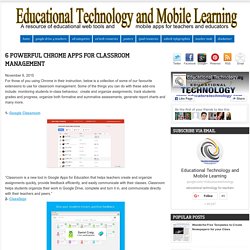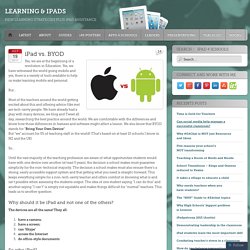

Get Over It! There are, no doubt, many technophobes (among educators and in general) out there.

Technophobia is defined by The Free Dictionary as: Related Redefining My Learning Silvana Meneghini and I work as Academic Technology Coordinators at Graded, the American School of São Paulo. " A flashlight in the fog of technology integration", initially the title of a conference workshop proposal, quickly developed into the desire of creating a framework to guide and coach teachers based on… 15.
In "Featured Carousel" Building a Professional Development Hub for your School- Part 3- Challenges This is part 3 in a series of posts: Building a Professional Development Hub for your School: Building a Professional Development Hub for your School- Part 1: Why? 26. Enhancement-Automating-Transforming-Informating I am constantly wrestling with the issue of using technology in schools to TEACH and to LEARN. 1. In "Education" Educational Technology and Mobile Learning: 6 Powerful Chrome Apps for Classroom Management. November 6, 2015 For those of you using Chrome in their instruction, below is a collection of some of our favourite extensions to use for classroom management.

Some of the things you can do with these add-ons include: monitoring students in-class behaviour, create and organize assignments, track students grades and progress, organize both formative and summative assessments, generate report charts and many more. 1- Google Classroom “Classroom is a new tool in Google Apps for Education that helps teachers create and organize assignments quickly, provide feedback efficiently, and easily communicate with their classes. Classroom helps students organize their work in Google Drive, complete and turn it in, and communicate directly with their teachers and peers.”2- ClassDojo “ ClassDojo helps teachers improve behavior in their classrooms quickly and easily.
“Seating and behavior charts are an essential parts of any good teacher’s tool kit. 6- Exit Ticket. UDL. You should know these. How to create a collaborative learning environment with technology. Tech Tools That Have Transformed Learning With Dyslexia. Fifth-grade teacher Kyle Redford remembers with emotion the day she unwittingly put an iPad in the hands of one of her 10-year-old dyslexic students, a day she called “a complete game changer.”

While the rest of the class was working in a writers workshop, she handed the student an iPad and told him to try and experiment with its speech-to-text feature. With minimal expectations, Redford figured that the newness and the boy’s curiosity would at least keep him busy during writing time, which he usually found frustrating. While Redford described the boy as “very bright,” he “couldn’t even compose a sentence to save his life” because of his dyslexia. Any classroom assignment having to do with writing made him moody. So, as Redford guided the rest of the class through the workshop, the student stepped outside the classroom and spoke his ideas for his writing assignment into the iPad.
At first, it was difficult. Gifted and talented education: using technology... Teaching with Technology: A More Meaningful Learning Experience Starts with Two Simple Questions - Faculty Focus. We are bombarded with information about online course supplements and the newest interactive multimedia components, all touted as the best approach to engage today’s learners in the online environment.

Dedicated practitioners puzzle over how, when, and where to incorporate multimedia within their online courses and further agonize over the potential effects of choosing not to do so. In this article, we propose that the real multimedia dilemma lies not in how, when, or where multimedia should be incorporated into online courses, but the crux of the matter lies determining why and what. A paradigm shift to focus on the intentional and meaningful inclusion of multimedia should be considered, particularly given the thrust and pressure for faculty to include multimedia innovations throughout their courses. Multimedia provides a plethora of tools to supplement online text, including graphics, audio, music, video, animation, and/or simulation.
Clark, R.C. & Mayer, R.E. (2002). BYOD. I’m a father of two girls (7 & 10) and like many fathers in developed world in 2015, school holiday time has become “constant screen time” for my kids.

Unless I painstakingly structure every minute of their day, given the choice, they pick screen time before considering other activities. They are kids after all and it may have been 1987 and it may have been an Atari ST, but I was just the same. The 70s gave us screen time, the 80s brought it home, the 90s expanded the choice and the 21st century has now given many young people the power to download further screen time options when they feel like it.
What’s good for kids? If most parents are allowing it, is it ok to deny your own kids (as a parent or teacher) the access other’s enjoy? So, what do we parents and teachers do with a generation who have increasingly higher expectations for how much screen time is considered normal? Idea 1: Make rules & reasons clear Idea 2: Make them earn this precious resource English : Sentopiary Like this: iPad vs. BYOD. Yes, we are at the beginning of a revolution in Education.

Yes, we have witnessed the world going mobile and yes, there is a variety of tools available to help us make learning mobile and personal. But… Most of the teachers around the world getting excited about this and offering advice (like me) are tech-savvy people. We have already had a play with many devices, we blog and Tweet all day, researching the best practice around the world. We are comfortable with the differences and know how those differences in features and software might affect a lesson. So… Until the vast majority of the teaching profession are aware of what opportunities students would have with one device over another (at least 5 years), the decision a school makes must guarantee simplicity for the non-technical majority.